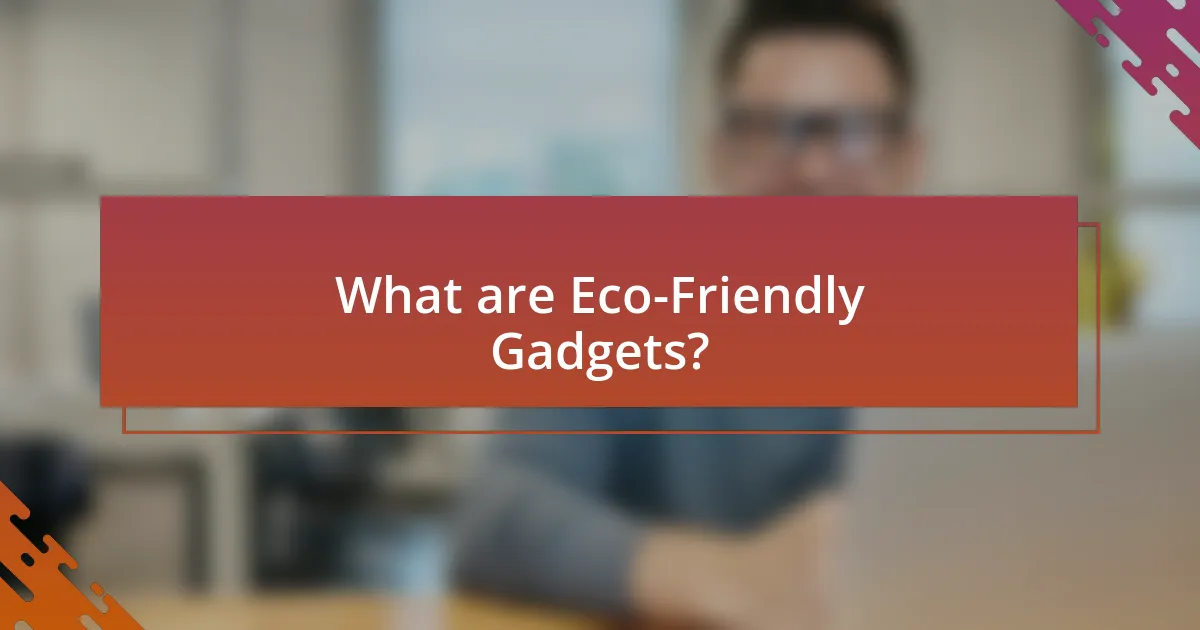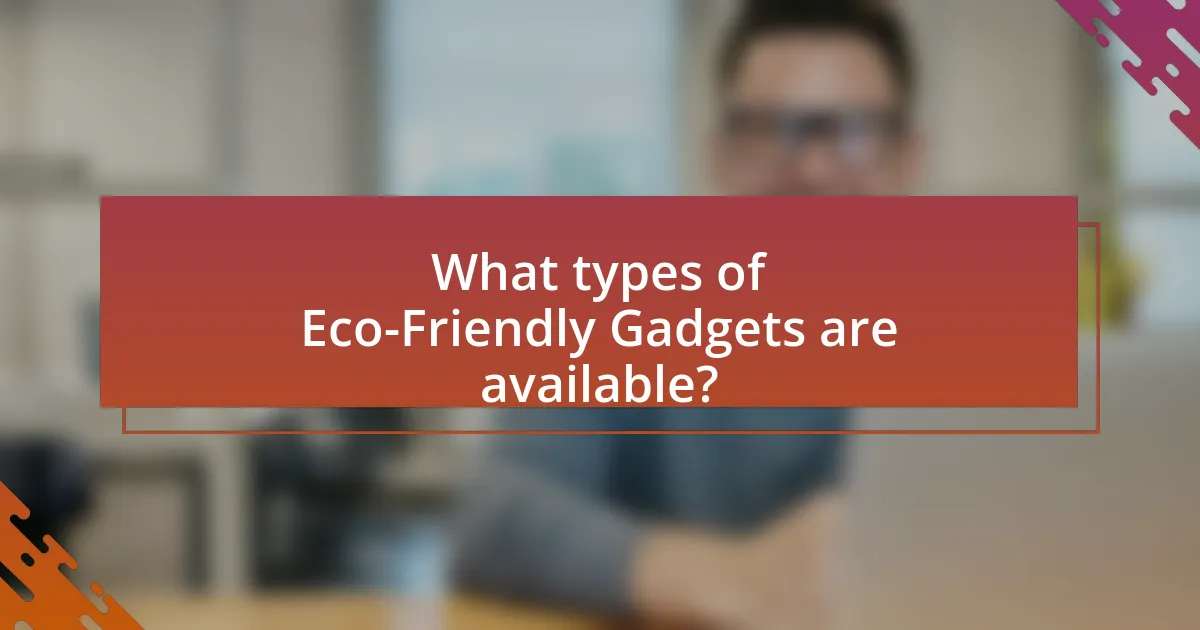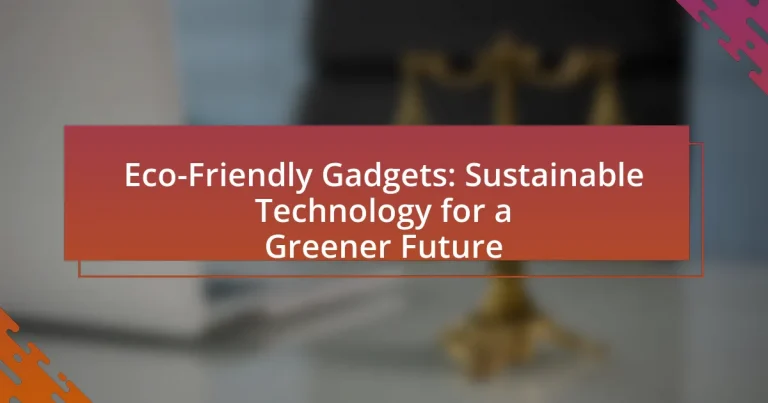Eco-friendly gadgets are devices designed to minimize environmental impact through sustainable materials, energy efficiency, and reduced waste. This article explores how these gadgets contribute to sustainability by utilizing renewable energy sources and energy-efficient technologies, such as solar chargers and LED lighting. It discusses the materials commonly used in eco-friendly gadgets, their environmental benefits, and the importance of adopting these technologies for a greener future. Additionally, the article highlights various types of eco-friendly gadgets, their functionalities, and tips for consumers on selecting and using these products effectively to reduce carbon footprints and promote sustainability.

What are Eco-Friendly Gadgets?
Eco-friendly gadgets are devices designed to minimize environmental impact through sustainable materials, energy efficiency, and reduced waste. These gadgets often utilize renewable energy sources, such as solar power, and are made from recyclable or biodegradable materials. For example, solar chargers convert sunlight into electricity, reducing reliance on fossil fuels. Additionally, energy-efficient appliances, like LED light bulbs, consume less power and have a longer lifespan compared to traditional options, contributing to lower energy consumption and waste.
How do Eco-Friendly Gadgets contribute to sustainability?
Eco-friendly gadgets contribute to sustainability by reducing energy consumption and minimizing waste through the use of renewable materials. These devices often incorporate energy-efficient technologies, such as LED lighting and low-power processors, which significantly lower electricity usage compared to traditional gadgets. For instance, according to the U.S. Department of Energy, using energy-efficient appliances can reduce energy consumption by 10-50%. Additionally, many eco-friendly gadgets are designed for longevity and recyclability, which helps decrease electronic waste. The Global E-waste Monitor reported that in 2019, 53.6 million metric tons of e-waste were generated globally, highlighting the importance of sustainable design in reducing this figure.
What materials are commonly used in Eco-Friendly Gadgets?
Eco-friendly gadgets commonly utilize materials such as recycled plastics, bamboo, organic cotton, and biodegradable materials. Recycled plastics reduce waste and energy consumption during production, while bamboo is a sustainable resource known for its rapid growth and strength. Organic cotton is cultivated without harmful pesticides, making it a safer choice for both the environment and human health. Biodegradable materials, such as plant-based bioplastics, decompose naturally, minimizing environmental impact. These materials collectively contribute to the sustainability and reduced ecological footprint of eco-friendly gadgets.
How do these materials impact the environment?
Eco-friendly materials significantly reduce environmental impact by minimizing pollution and resource depletion. For instance, biodegradable plastics break down naturally, decreasing landfill waste and harmful emissions associated with traditional plastics. Additionally, materials like bamboo and recycled metals require less energy to produce, leading to lower carbon footprints. Research indicates that using sustainable materials can reduce greenhouse gas emissions by up to 50% compared to conventional materials, highlighting their positive role in mitigating climate change.
Why are Eco-Friendly Gadgets important for a greener future?
Eco-friendly gadgets are important for a greener future because they reduce environmental impact by minimizing energy consumption and waste. These devices often utilize renewable resources, such as solar power, and are designed to be more efficient than traditional gadgets, which contributes to lower carbon emissions. For instance, according to a report by the International Energy Agency, energy-efficient technologies could reduce global energy demand by 30% by 2040, significantly mitigating climate change effects. By adopting eco-friendly gadgets, consumers can actively participate in sustainability efforts, promoting a healthier planet for future generations.
What role do Eco-Friendly Gadgets play in reducing carbon footprints?
Eco-friendly gadgets significantly reduce carbon footprints by utilizing sustainable materials and energy-efficient technologies. These devices often consume less power, leading to lower greenhouse gas emissions during their operation. For instance, solar-powered chargers harness renewable energy, minimizing reliance on fossil fuels. Additionally, many eco-friendly gadgets are designed for longevity and recyclability, which decreases waste and the carbon emissions associated with manufacturing new products. Research indicates that adopting energy-efficient technologies can reduce energy consumption by up to 30%, directly impacting carbon footprint reduction.
How do Eco-Friendly Gadgets promote energy efficiency?
Eco-friendly gadgets promote energy efficiency by utilizing advanced technologies that reduce power consumption and enhance performance. For instance, devices like LED light bulbs consume up to 80% less energy than traditional incandescent bulbs while providing the same level of brightness. Additionally, smart thermostats optimize heating and cooling systems by learning user habits, which can lead to energy savings of 10-15% annually. These gadgets often incorporate renewable energy sources, such as solar panels, which further decrease reliance on fossil fuels and lower overall energy usage.

What types of Eco-Friendly Gadgets are available?
Eco-friendly gadgets include solar chargers, energy-efficient appliances, biodegradable phone cases, and smart thermostats. Solar chargers harness sunlight to power devices, reducing reliance on fossil fuels. Energy-efficient appliances, such as those rated by ENERGY STAR, consume less electricity, contributing to lower carbon emissions. Biodegradable phone cases are made from materials that decompose naturally, minimizing plastic waste. Smart thermostats optimize heating and cooling systems, leading to significant energy savings. These gadgets collectively promote sustainability and reduce environmental impact.
How do solar-powered gadgets work?
Solar-powered gadgets work by converting sunlight into electrical energy using photovoltaic cells. These cells, typically made of silicon, absorb photons from sunlight, which excites electrons and generates a flow of electricity. This electricity can then be used to power the gadget directly or stored in batteries for later use. According to the U.S. Department of Energy, solar energy is a renewable resource that can significantly reduce reliance on fossil fuels, making solar-powered gadgets an eco-friendly option for sustainable technology.
What are some examples of solar-powered Eco-Friendly Gadgets?
Examples of solar-powered eco-friendly gadgets include solar chargers, solar-powered lights, solar water heaters, and solar-powered Bluetooth speakers. Solar chargers convert sunlight into electricity to charge devices like smartphones and tablets, making them ideal for outdoor activities. Solar-powered lights utilize photovoltaic cells to provide illumination without relying on the grid, enhancing energy efficiency in gardens and pathways. Solar water heaters harness solar energy to heat water for residential use, significantly reducing energy consumption. Solar-powered Bluetooth speakers offer portable audio solutions while minimizing environmental impact through renewable energy use. These gadgets exemplify the integration of sustainable technology into everyday life, promoting a greener future.
What are the benefits of using solar-powered gadgets?
Solar-powered gadgets offer significant benefits, including reduced energy costs and environmental impact. By harnessing solar energy, these devices decrease reliance on fossil fuels, leading to lower greenhouse gas emissions. For instance, a study by the National Renewable Energy Laboratory indicates that solar energy can reduce carbon dioxide emissions by up to 90% compared to traditional energy sources. Additionally, solar-powered gadgets often require less maintenance and have longer lifespans, as they are designed to operate efficiently without the need for frequent battery replacements. This combination of cost savings and sustainability makes solar-powered gadgets a compelling choice for eco-conscious consumers.
What are biodegradable gadgets?
Biodegradable gadgets are electronic devices designed to decompose naturally in the environment after their useful life, minimizing waste and pollution. These gadgets are typically made from materials such as bioplastics, organic compounds, or other sustainable resources that break down through natural processes, unlike traditional electronics that can persist in landfills for hundreds of years. For example, a study published in the journal “Environmental Science & Technology” highlights that bioplastics can reduce plastic waste significantly, supporting the transition to more sustainable technology solutions.
How do biodegradable gadgets break down in the environment?
Biodegradable gadgets break down in the environment through natural processes involving microorganisms, moisture, and temperature. These gadgets are typically made from materials like bioplastics, which are designed to decompose when exposed to these environmental conditions. For instance, studies have shown that under optimal conditions, such as in composting environments, these materials can break down within a few months to a couple of years, depending on the specific composition and environmental factors. This breakdown process results in the conversion of the gadget into natural substances like water, carbon dioxide, and biomass, thus minimizing environmental impact.
What are the advantages of using biodegradable materials in gadgets?
The advantages of using biodegradable materials in gadgets include reduced environmental impact, enhanced sustainability, and improved waste management. Biodegradable materials decompose naturally, minimizing landfill waste and pollution compared to traditional plastics, which can take hundreds of years to break down. For instance, a study published in the journal “Environmental Science & Technology” found that biodegradable plastics can reduce greenhouse gas emissions by up to 68% during their lifecycle compared to conventional plastics. Additionally, using biodegradable materials promotes a circular economy, where products can be returned to the environment safely, supporting ecological balance and resource conservation.

How can consumers choose Eco-Friendly Gadgets?
Consumers can choose eco-friendly gadgets by looking for products that are energy-efficient, made from sustainable materials, and have a minimal environmental impact throughout their lifecycle. Energy-efficient gadgets often have certifications such as ENERGY STAR, indicating they consume less electricity. Products made from recycled or biodegradable materials reduce waste and resource consumption. Additionally, consumers should consider the longevity and repairability of gadgets, as longer-lasting products contribute to less electronic waste. According to the Global E-waste Monitor 2020, 53.6 million metric tons of e-waste were generated globally, highlighting the importance of selecting gadgets that are designed for sustainability.
What features should consumers look for in Eco-Friendly Gadgets?
Consumers should look for energy efficiency, sustainable materials, and recyclability in eco-friendly gadgets. Energy efficiency ensures that the device consumes less power, reducing carbon footprints; for instance, Energy Star-rated products use up to 30% less energy than non-rated counterparts. Sustainable materials, such as biodegradable plastics or recycled metals, minimize environmental impact during production and disposal. Lastly, recyclability allows consumers to dispose of gadgets responsibly, contributing to a circular economy, as evidenced by the fact that only 20% of electronic waste is recycled globally, highlighting the importance of this feature.
How can consumers verify the sustainability claims of gadgets?
Consumers can verify the sustainability claims of gadgets by researching certifications, examining materials used, and reviewing third-party assessments. Certifications such as Energy Star, EPEAT, and the Forest Stewardship Council indicate adherence to sustainability standards. Additionally, consumers should investigate the materials, looking for recycled or eco-friendly components, which can be found in product specifications. Third-party assessments, including reports from organizations like Greenpeace or the Carbon Trust, provide independent evaluations of a product’s environmental impact, further validating sustainability claims.
What certifications indicate a gadget is eco-friendly?
Certifications that indicate a gadget is eco-friendly include Energy Star, EPEAT, and the Forest Stewardship Council (FSC) certification. Energy Star signifies that a product meets energy efficiency guidelines set by the U.S. Environmental Protection Agency, reducing greenhouse gas emissions. EPEAT evaluates electronic products based on their environmental impact throughout their lifecycle, ensuring they meet strict criteria for sustainability. The FSC certification ensures that wood and paper products come from responsibly managed forests, promoting sustainable forestry practices. These certifications provide consumers with assurance that the gadgets they purchase are environmentally friendly and contribute to sustainability efforts.
What are some tips for using Eco-Friendly Gadgets effectively?
To use eco-friendly gadgets effectively, prioritize energy efficiency by selecting devices with high Energy Star ratings, which can reduce energy consumption by up to 30%. Additionally, utilize smart power strips to prevent phantom energy loss when devices are not in use. Regularly update software on gadgets to ensure optimal performance and energy efficiency, as updates often include improvements that reduce power usage. Finally, practice proper disposal and recycling of old gadgets to minimize electronic waste, as approximately 50 million tons of e-waste are generated globally each year, which can harm the environment if not managed correctly.
How can users maximize the lifespan of Eco-Friendly Gadgets?
Users can maximize the lifespan of eco-friendly gadgets by following proper maintenance practices, such as regular cleaning, avoiding extreme temperatures, and using compatible accessories. Regular cleaning prevents dust and debris from affecting performance, while avoiding extreme temperatures protects sensitive components. Additionally, using compatible accessories ensures that devices operate efficiently without causing damage. Research indicates that proper care can extend the lifespan of electronic devices by up to 30%, highlighting the importance of these practices in maintaining eco-friendly gadgets.
What common mistakes should consumers avoid when using Eco-Friendly Gadgets?
Consumers should avoid assuming that all eco-friendly gadgets are automatically energy-efficient. Many products marketed as eco-friendly may still consume significant energy if not used properly. For instance, failing to optimize settings or neglecting to turn off devices when not in use can lead to unnecessary energy consumption. Additionally, consumers often overlook the importance of proper disposal; eco-friendly gadgets still require responsible recycling to prevent environmental harm. Research indicates that improper disposal of electronic waste contributes to toxic pollution, undermining the benefits of using eco-friendly products. Therefore, understanding energy usage and disposal methods is crucial for maximizing the sustainability of eco-friendly gadgets.
What are the future trends in Eco-Friendly Gadgets?
Future trends in eco-friendly gadgets include increased use of renewable materials, enhanced energy efficiency, and the integration of smart technology for sustainability. Manufacturers are increasingly adopting biodegradable and recycled materials, such as bioplastics, to reduce environmental impact. Energy-efficient designs, such as solar-powered devices and low-energy electronics, are becoming standard as consumers demand lower carbon footprints. Additionally, smart technology is being utilized to optimize energy consumption, with devices that can monitor usage patterns and adjust settings accordingly. According to a report by Grand View Research, the global green technology and sustainability market is expected to reach $36.6 billion by 2025, indicating a strong shift towards eco-friendly innovations in consumer electronics.
How is technology evolving to create more sustainable gadgets?
Technology is evolving to create more sustainable gadgets through advancements in materials, energy efficiency, and recycling processes. Innovations such as biodegradable plastics and recycled metals are being utilized to reduce environmental impact. For instance, companies like Fairphone are designing modular smartphones that allow for easy repairs and upgrades, extending the product’s lifespan and minimizing electronic waste. Additionally, energy-efficient components, such as LED lighting and low-power processors, are being integrated into devices to decrease energy consumption. According to a report by the International Energy Agency, energy-efficient technologies could reduce global energy demand by 12% by 2040, highlighting the significant impact of these advancements on sustainability.
What innovations are on the horizon for Eco-Friendly Gadgets?
Innovations on the horizon for eco-friendly gadgets include advancements in biodegradable materials, energy-efficient technologies, and smart devices that optimize resource usage. Biodegradable materials, such as mycelium and plant-based plastics, are being developed to replace traditional plastics in gadgets, reducing environmental impact. Energy-efficient technologies, like solar-powered chargers and energy-harvesting devices, are becoming more prevalent, allowing gadgets to operate with minimal energy consumption. Additionally, smart devices equipped with AI can analyze user behavior to optimize energy use, further promoting sustainability. These innovations are supported by research indicating that the global market for eco-friendly gadgets is expected to grow significantly, driven by increasing consumer demand for sustainable products.
How can individuals contribute to a greener future with Eco-Friendly Gadgets?
Individuals can contribute to a greener future with eco-friendly gadgets by choosing energy-efficient devices that reduce electricity consumption. For instance, using LED light bulbs can save up to 75% more energy than traditional incandescent bulbs, significantly lowering carbon emissions. Additionally, opting for gadgets made from sustainable materials, such as bamboo or recycled plastics, minimizes environmental impact. Research indicates that the production of electronic devices accounts for about 20% of global greenhouse gas emissions; therefore, selecting eco-friendly options helps mitigate this issue. Furthermore, individuals can support companies that prioritize sustainability in their manufacturing processes, fostering a market for greener technologies.
What lifestyle changes can enhance the impact of using Eco-Friendly Gadgets?
Adopting a minimalist lifestyle can significantly enhance the impact of using eco-friendly gadgets. By reducing consumption and focusing on essential items, individuals can decrease waste and energy usage, thereby maximizing the benefits of their eco-friendly devices. For instance, studies show that minimalism can lead to a 25% reduction in household waste, which complements the energy efficiency of eco-friendly gadgets. Additionally, prioritizing renewable energy sources, such as solar power, for charging these gadgets further amplifies their positive environmental impact, as solar energy reduces reliance on fossil fuels.
How can communities promote the use of Eco-Friendly Gadgets?
Communities can promote the use of eco-friendly gadgets by organizing awareness campaigns and workshops that educate residents about the benefits of sustainable technology. These initiatives can include demonstrations of eco-friendly gadgets, highlighting their energy efficiency and reduced environmental impact. For instance, a study by the International Energy Agency indicates that energy-efficient devices can reduce household energy consumption by up to 30%. Additionally, communities can incentivize the purchase of eco-friendly gadgets through local subsidies or tax rebates, making them more financially accessible. By fostering partnerships with local businesses that sell eco-friendly products, communities can create a supportive ecosystem that encourages sustainable choices among residents.



